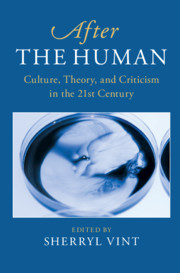Book contents
- After the Human
- After Series
- After the Human
- Copyright page
- Contents
- Contributors
- Acknowledgments
- Introduction
- Part I After Humanism
- Chapter 1 Historicizing Posthumanism
- Chapter 2 Poststructuralism and the End(s) of Humanism
- Chapter 3 Postmodernism
- Chapter 4 Embodiment and Affect
- Chapter 5 Requiem for a Digital Humanist
- Part II New Objects of Enquiry
- Part III Posthumanities
- Collective Works Cited
- Index
Chapter 3 - Postmodernism
from Part I - After Humanism
Published online by Cambridge University Press: 26 November 2020
- After the Human
- After Series
- After the Human
- Copyright page
- Contents
- Contributors
- Acknowledgments
- Introduction
- Part I After Humanism
- Chapter 1 Historicizing Posthumanism
- Chapter 2 Poststructuralism and the End(s) of Humanism
- Chapter 3 Postmodernism
- Chapter 4 Embodiment and Affect
- Chapter 5 Requiem for a Digital Humanist
- Part II New Objects of Enquiry
- Part III Posthumanities
- Collective Works Cited
- Index
Summary
This chapter analyzes the relation between postmodernism and posthumanism. While postmodernism, as an aesthetic and philosophical practice, has lost some of its relevance in the academy, several of its underlying gestures, the primary being the interrogation of the humanist model of subjectivity, live on in various versions of posthumanism. The central concern here, first, will be to examine Derrida’s concept of the trace (in his essay “Differance”); the chapter then moves on to suggest that Derrida’s quintessentially postmodern reading of the subject— differentiated, displaced, and other to itself—finds new expression in various canonical versions of posthumanism (in Hayles, Haraway, and Braidotti). Ultimately, the chapter examines how Derrida’s model of the subject persists as a kind of haunting in posthumanist thought, how postmodernism operates as a prefiguring trace of posthumanism.
- Type
- Chapter
- Information
- After the HumanCulture, Theory and Criticism in the 21st Century, pp. 44 - 57Publisher: Cambridge University PressPrint publication year: 2020
- 2
- Cited by

